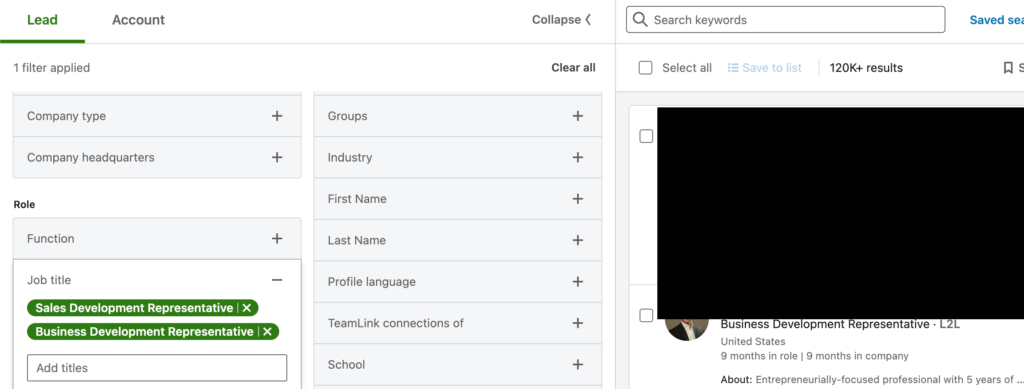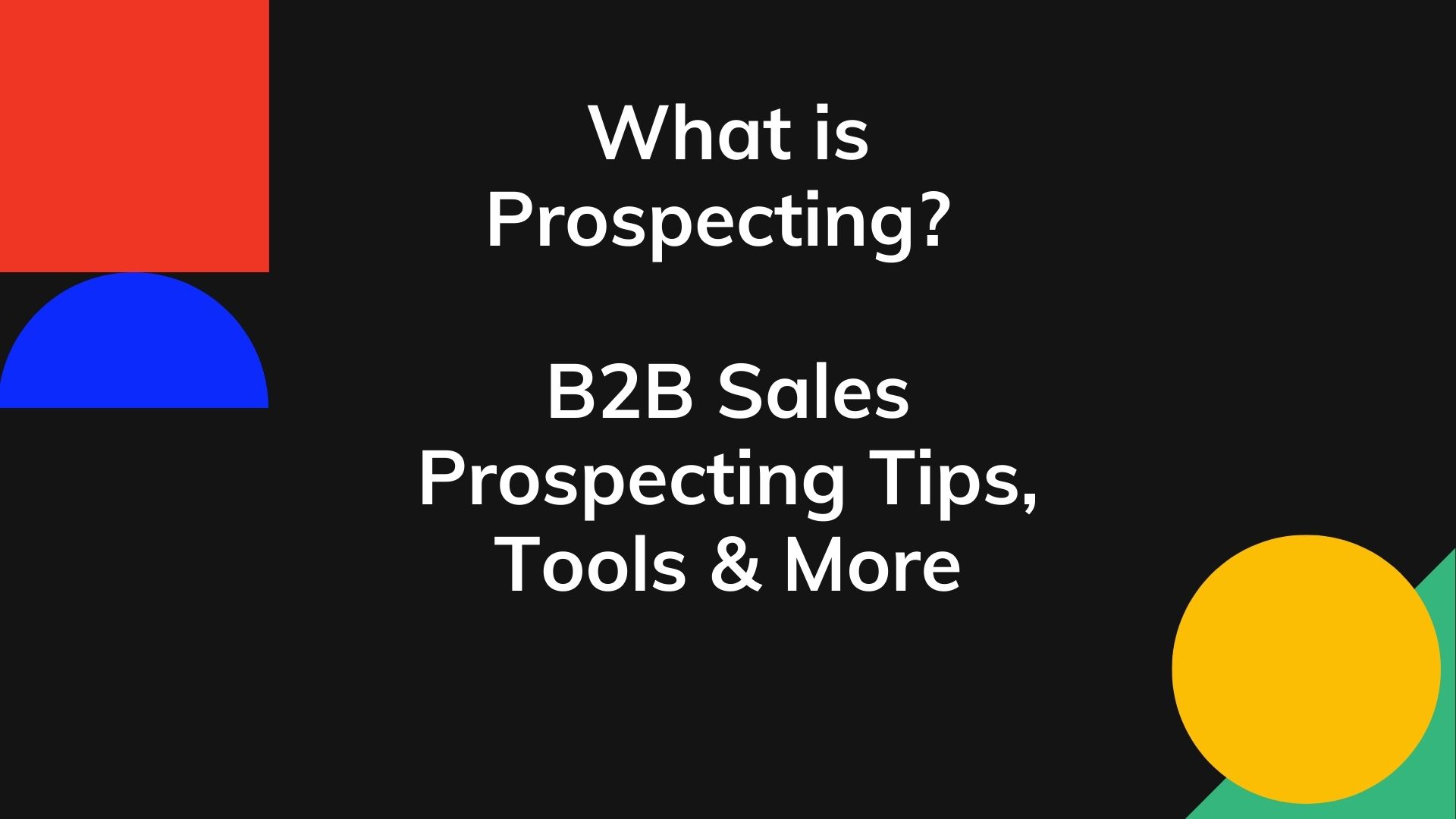If you’ve been in sales for awhile, you can answer the question, what is prospecting? However, if you’re new to sales, maybe you’re a Founder who knows they need to do sales prospecting but aren’t quite sure what prospecting means, then this article will give you a complete understanding. If you have sales experience, you’ll till find value in reading about prospecting tips, processes, and B2B sales prospecting tools.
What is Prospecting
Prospecting is the first step in a sales process where a company identifies a person who is a fit for the solution being sold and reaches out with the goal of starting a conversation that will lead to a sales cycle. The first conversation in sales prospecting is typically a scheduled meeting. Prospecting can be done via various methods.
What is a Sales Prospect
A prospect is a person or company who is reasonably believed to be a future customer or client.
Why Is Prospecting Important In Sales?
Prospecting is important to sales because it’s the first step in the sales process that gets potential buyers in the sales funnel. The more sales prospecting a sales team does, the more likely they will be to build a larger sales pipeline. Assuming they are adding qualified sales prospects to their sales funnel, they can ensure they have a healthy sales pipe with succesfull B2B sales prospecting.
Prospecting is also within the control of the company and becomes a math equation. If the company knows they will book two meetings from 100 cold calls and one of those two meetings will become a qualified sales opportunity, that becomes the first numbers a company can use to forecast sales. If they were to close 50% of their qualified opportunties, it would take 200 cold calls to win one new client from prospecting.
Types of Sales Prospects
Cold Prospects – Cold prospects are prospects you have no relationship with and have no reason to be expecting your message. These are the hardest prospects to get in contact with when conducting sales prospecting.
Warm Prospects – These types of prospects would reasonably expect a salesperson to reach out. It’s likely they have had some interaction with your company before. They may have joined a webinar and requested additional material. They may have also submitted a demo request. These prospects are significantly easier to book meetings with than cold prospects because they’ve been “warmed up.”
Closed Lost Prospects– These prospects have had a sales interaction with your company before and either were not ready to buy or your Account Executive was unable to close a deal with them. These prospects are often overlooked when it comes to B2B sales prospecting as far as prospects to connect with.
Tier 1 Prospects – Prospects who are a great fit for your company. They fit your ICP perfectly.
Tier 2 Prospects – Generally a good fit for your company but not a perfect fit. Spend more time focusing on Tier 1 prospects.
Sales Prospecting Challenges
Time consuming – When it comes to B2B sales prospecting, the biggest challenge is that it can’t effectively be automated. It requires a human being to spend time on. There are of course parts that can be automated but no matter what you believe, the more time you spend prospecting, the better the results will be. It’s almost guaranteed that if you spend 20 hours a week on prospecting you can double your results from 10 hours per week.
Rejection – Unless you’re a robot, rejection can kill prospecting morale. The best way to overcome is to take a longer term view. If you keep at it and iterate on your prospecting methods, it’s likely your results will improve.
Expensive – An SDR can easily cost a company $75,000 per year with salary, bonus, and software expenses. Despite being a junior hire, it’s still not cheap. And if you look overseas for sales outsourcing or SDR outsourcing, you may be able to find someone good, but it will not be easy.
Noisy – There are over 120K SDRs and BDRs according to LinkedIn Sales Navigator, conducting their B2B sales prospecting activities. That is a lot of cold emails, cold calls, and LInkedIn messages. Your number one competitor for prospecting is noise.

It’s Hard – Sales prospecting is hard because it’s a grind, thankless, and filled with rejection. Sales prospects have sometimes dozens of cold emails a day from SDRs trying to get on their calendar. Nobody wants to add another meeting to their calendar.
B2B Sales Prospecting Tips
Time Block – One of the hardest parts of sales prospecting is dedicating enough time to prospecting. It’s too easy to say that you’ll get to it later or push it off for the evening. Even if you sit down to begin prospecting, the repetitive nature makes it easy to take a break and check your email or social media. That’s why time blocking is key for having success with B2B sales prospecting. Time blocking means blocking off a set period of time, usually an hour, where you dedicate that time exclusively to prospecting.
Turn Off Your Cell Phone – Given the repetitive nature of prospecting, it’s easy to get distracted and reach for your phone for a quick endorphin hit. Turning off your cell phone, assuming you don’t need it to hammer through your cold call list, means you’ll be able to focus and hit maximum prospecting efficiency for that time blocked hour.
Build Lists In Advance – Ideally, if you have the resources, you use a site like Upwork or Fiverr or you have a B2B database tool like ZoomInfo, Cognism, or SalesIntel, that makes it easy to create a prospecting list. You don’t want to spend most of your time looking up one contact at a time. That is inefficient. You should have a list of enough prospects that when you begin your sales prospecting, you can focus on the prospecting activities, not trying to look up their email or find their business phone numbers which is why it makes sense to spend money on a B2B data provider or to buy the best business leads available.
Keep The Emotions Out – Rejection with sales prospecting is inevitable. You’ll not only hear a lot of people say they’re not interested or to take them off your list, there will also be the occasional rude person who can ruin your day. It’s easier said than done, but doing your best to separate yourself from the outcome of prospecting is key to staying focused. If you were to take rejection personally, you’ll never succeed.
Outsource Repetitive Tasks – If you do not have a place to buy business leads and you are required to build lists manually, you should see if you can outsource the list building to a site like Fiverr. The reason is that this can not only save you a ton of time, the cost is negligible.
Don’t Over-Optimize for Time/Day – There is certainly data on the best time to make a cold call or send an email. However, the actual best time to prospect is right now. The hardest part about prospecting is doing it. If you try to optimize too much, you’ll push it off until the best possible time. You will create a habit of procrastination and use a study as a reason to push off your sales prospecting.
Sunday Evenings are Good for Senior Level Prospects – Senior level leaders at companies check their email like everyone else. They’ll often read emails or do a little work on Sunday evening. It’s a great time to block off 30 minutes if you’re going after the C-suite or VPs at larger companies as a way to get around the gatekeepers.
Startup Founder Prospecting – Founders tend to work unusual hours. Emailing them outside of normal business hours, especially late in the evening is an effective way to get your message seen.
90 Days on LinkedIn – On LinkedIn Sales Navigator, there is a filter for people who have changed jobs in the past 90 days. This is useful for sourcing prospects who are something like 2-10x more likely to be in the market to buy a solution. The reason is that if a senior decision maker has recently switched jobs, it’s likely they need to make an impact and solve company problems. This can be a good time to target job changers when prospecting because they are more likely to buy with a fresh budget.
Combine Prospecting Channels – Any inside sales consultant or sales manager will tell you that SDRs have the most success when they combine prospecting channels. This means running outbound sequences during your B2B sales prospecting by using LinkedIn, Email, Cold Calling and other channels. An outbound sequences is a series of steps an SDR will follow when they do their sales prospecting.
Leverage Referrals – Referrals are often overlooked and an easier way to book a meeting with a new prospect. Find happy clients and ask them if they know anyone who would also benefit from the product or service you offer. Check out their previous companies and see if there are any prospects there who they might be able to make an introduction to. You can also ask your marketing team to look at implementing a referral marketing program.
Track Opens – Most sales prospecting tools for sending emails offer the ability to track opens. After you’ve completed your sales prospecting, you may want to follow up on emails that have been opened multiple times. Seeing multiple email opens may mean the prospect is reading your email many times or they’ve forwarded it to other people in their organization. If you have location tracking enabled, you’ll see if the email is being forwarded around. It usually signals that there is some level of interest.
Other B2B Sales Prospecting Tips
90 day rule – The work you do today, shows up in 90 days. If you slack for a week, you will pay for that slacked week in 90 days when you have a gap in your sales pipeline. That is why consistent sales prospecting is key to long term, steady success.
Double Down – If you learn that a certain subject line has a significantly higher open rate, use it as much as possible until it doesn’t work. If cold calling is the most effective sales prospecting method, then you need to double down on it and not worry about the other channels.
Provide Value – When prospecting, you do not always want to go for the meeting. If you can share unique, relevant, high quality content that the prospect might care about, that can be an effective B2B sales prospecting approach. Staying on top of industry trends is also important for relevant messaging and conversations.
Advanced Sales Prospecting Tips
Career Pages – If you’re prospecting into larger organizations or selling to senior people, it’s important to do your research. Career pages can tell you a lot about your prospects so you can improve your chances of writing a relevant message during your sales prospecting outreach. Things to look for include; software used, roles and their responsibilities, and understand where they are investing their money. Hiring is expensive so you’ll be able to understand where the company is focused.
Map Out Org – The better you understand an organization, the better you can navigate it for greater success with sales prospecting. This is more relevant to larger organizations for enterprise SDRs and BDRs.
News Alerts – Using Google News Alerts is an easy way to stay on top of what is going on at an organization. There are also tools like CheetahIQ that track news events. News alerts give you a trigger event to reach out. Maybe a new initiative has been announced that is relevant to your product offering or there’s another reason you can prospect the company that’s timely.
10-Ks and Earning Calls – For publicly traded companies, they provide public reports once a year called 10-Ks that are loaded with company intelligence. There are useful resources that can be leveraged that mention strategy and goals. Earnings calls happen every 12 weeks and provide a quarterly update on the business from the C-Suite. They’ll discuss goals, challenges, provide a business update, and answer questions from analysts. This information can be used when prospecting to create unique, relevant messaging that other salespeople overlook.
Podcasts – Podcasts are more popular than ever and there are plenty of B2B company leaders you may want to reach out to. You can find prospects who’ve appeared on podcasts, listen to parts of the episode, and reference that in your outreach to personalize it a bit.
Leverage Intent Data – There are many intent data providers that companies can use to focus on more targeted B2B sales prospecting efforts.
Get Creative – Here’s a list of creative sales outreach ideas that should be used for high value prospects.
Sell The Meeting, Not The Product – Inexperienced salespeople and Founders who don’t know how to sell will often try to sell the product instead of selling the meeting. The prospect isn’t ready to buy and effective B2B sales prospecting relies on capturing attention with relevant value to get time on the calendar.
Sales Messaging, Not Marketing – Shorter, to the point, people read on mobile, no buzz words, no fluff, soft calls to action.
The Number One Sales Prospecting Tip
Activity X Quality is your formula for success.
The formula for sales prospecting is simple. The more high value activity you do, the more sales prospecting success you’ll have. You have to balance doing enough activity with doing enough of it at a high enough quality level. There are diminishing returns on quality for sales prospecting which is why you don’t want to overdo it with the perceived quality of your emails and you need to make sure your volume of activity is high enough. Most prospects are going to ignore you.
Sales Prospecting Methods
When it comes to B2B sales prospecting methods, the method you choose can be dependent on the type of customer you’re prospecting. If it’s a local small business owner, it’s likely cold calls are the most effective. They may not check their email at all or they may not even have a work email address. For senior leadership at a large organization, combining sales prospecting methods is the best approach.
Email – Cold email is by far the most popular prospecting method because it provides scalability and allows a salesperson to be data driven. Rejection with cold email is less likely to sting as compared to hearing someone be rude over the phone when making cold calls. Email also allows you to A/B test messaging. If a certain message is working, then it can quickly be scaled up.
Despite all the cold email tips available, reply rates have been declining because of the proliferation of tools that make it easy to send hundreds of emails per day. Email deliverability has also taken a hit which means companies need to use email warm up tools to ensure deliverability is strong.
Cold Call – Despite what some people say, cold calling still works. There are plenty of reasons why. One is that too many people rely on email making the cold call a less noisy B2B sales prospecting method. Another is that it puts people on the spot so you capture their attention which allows a salesperson to have a shot of convincing them to take a meeting.
LinkedIn – LinkedIn for most industries is a gold mine for sales prospecting. You can not only research prospects, you can also use LinkedIn Premium and LinkedIn Sales Navigator to send messages and connect with relevant prospects. Combined with effective social selling, such as creating regular LinkedIn posts, a salesperson can have great success using LinkedIn for their B2B sales prospecting. One tip: don’t connect and immediately pitch. Be careful of using automation tools on LinkedIn.
Twitter – Twitter has tons of startup founders, CEOs and other senior leaders who use it regularly. A drawback to LinkedIn is that, like cold email, it has become overrun and overused by salespeople for prospecting. It still works but it’s not easy. Twitter on the other hand is virtually ignored by salespeople. If a prospect has their DMs open, it can be an easy way to get your prospecting message in front of them.
Direct Mail – Direct mail has seen a recent resurgence because of tools like Reachdesk and Sendoso. These tools enable salespeople to send gifts to their prospects. This B2B sales prospecting method is a great way to cut through the noise and allows a salesperson to capture the attention of their prospect. It can be expensive but if your deal size and close rate justify the expense, it’s a fantastic way to get more meetings on the calendar.
Communities – Every industry now has a relevant Slack, Discord, Facebook group or other online community that you can join. You do not want to join and start pitching your offering. Direct messaging people is a great way to get banned if there isn’t a good reason to reach out. But like Social Selling on LinkedIn, there will be opportunities to provide a recommendation, demonstrate your expertise, or someone may ask for a recommendation where you can help.
Referrals – Referrals are one of the highest converting sales prospecting methods. The surprising thing about them is that salespeople and business owners do not have a proactive strategy for asking for referrals. Booking new meetings is already hard enough. But if you have happy customers, you can be sure you’ll have an easier time if you ask properly.
Bottom Up or Top Down Sales Prospecting – When doing outreach you have two choices for sales prospecting into larger companies. You can go to the top of the organization, to the C-suite or VP level or start at the individual contributor/manager level to get your foot in the door. Every organization is different. The C-suite is harder to crack but easier to work with. The Manager level is easier to book time with but often lacks the necessary decision making power.
The Prospecting Process
Define ICP and Buyer Persona – Before you start prospecting, define your ideal customer profile. List your ICP out in detail. Because you’ll be reaching out to more than one person at the company when you conduct your sales prospecting, you need to map out your buyer personas. Understand their roles, and more importantly, understand the problems they face. List this out and keep it in a saved document for a later step.
Deeply Understand Their Problems – It’s not enough to know about the surface level of the problem faced by your prospects. The more deeply you can understand it, the better your messaging will be. When you get them on a cold call, you’ll be able to make them think not only have you solved this problem, but you’ve solved it for them. The same goes for your messaging.
Create Messaging That is Relevant – It’s easy to keep things generic about problems or pains faced by your prospects in your sales prospecting messaging. You need to make sure not only do you understand the prospect’s problems, you need to craft the message in a way that is relevant. A CFO will care about different things than a Finance Manager. Ensuring your messaging is relevant is key to prospecting success. Come up with variations of messaging. Don’t overthink it.
Begin Outreach – Once you have your messaging written down for your buyer personas, it’s time to begin your sales prospecting. If you’re only making cold calls, make sure you’ve blocked off time each day to make a minimum of 80 calls. If you’re running outbound sequences, you want to have a mix of personalized, relevant emails and templated emails. Spend more time on your tier 1 prospects than your tier 2 prospects.
Track Data – If you’re doing any cold emailing, make sure to use a sales engagement platform for your B2B prospecting so you have data that can guide your decision making. You will be able to optimize open rates, reply rates, and meeting booked rates by A/B testing different parts of your messaging. With cold calling you don’t wan to create new cold call pitches. Try your best to use the same pitch so you can get a large enough sample to decide what is working and what is not. Keep in mind the pitch may be better for a different prospect.
Iterate – B2B sales prospecting should be an iterative approach. If you think a cold email is great but it isn’t converting, follow the data, not your gut.
B2B Sales Prospecting Tools
Data Providers – When it comes to sales prospecting data providers, you can check out the best places to buy business leads, ZoomInfo Competitors, tools like ZoomInfo, Cognism, Uplead and free email finders if you don’t have the budget.
Sales Engagement Platforms – Sales engagement platforms are widely used among b2b sales prospecting teams. They include category leaders like Salesloft, Outreach, Apollo. If these aren’t a fit, check out Salesloft competitors and alternatives and Outreach competitors and alternatives.
Cold Calling Tools – There are many tools that can make cold calling more efficient like ConnectandSell, Phoneburner, and others.
Video Prospecting Tools – Video is a great way to cut through noise and add to your outbound sequence. Tools like Vidyard, BombBomb, Loom, and Loom alternatives are options to consider.
Direct Mail Prospecting Tools – Direct mail is a great way to also cut through the noise. Reachdesk and Sendoso are category leaders, there are also other Sendoso competitors and alternatives. View our Sendoso vs Reachdesk comparison.
What is Prospecting – Conclusion
When it comes to understanding what is prospecting, it’s important to know that is the lifeblood of every B2B sales driven organization. B2B sales prospecting is what drives the top of the funnel and leads to predictable revenue growth. If you’re looking for more prospecting strategies, we’ve got you covered.



